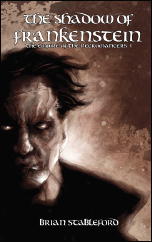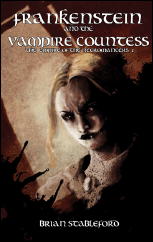Mon 28 Dec 2009
A Review by Walter Albert: BRIAN STABLEFORD – The Shadow of Frankenstein.
Posted by Steve under Reviews[3] Comments

BRIAN STABLEFORD – The Shadow of Frankenstein: The Empire of the Necromancers #1. Black Coat Press; trade paperback, 2008.
Stableford, who has translated a number of French nineteenth-century thrillers, begins a saga conceived of as a sequel to Paul Féval’s John Devil, originally published in France in 1861 but recently translated by Stableford and published by Black Coat Press in 2005.
In his introduction to Shadow of Frankenstein Stableford describes John Devil as “a long and complicated duel of wits” between John Devil, a legendary figure whose identity is something of a mystery, and Gregory Temple, an English detective.
Temple’s career has been damaged by John Devil, but in the sequel Temple is back on the job, in pursuit of his arch-enemy, reluctantly accepting the help of Ned Knob, a secondary character in Féval’s novel who, in the continuation, assumes a major role, demonstrating both intelligence and some moral fibre as he seeks to find his place between the rational world of Temple and the messianic vision of John Devil.

Stableford merges the Frankenstein mythos and the very real traffic in dead bodies that was a major source for cadavers used in medical research to create a vision of a world in which a means of achieving physical resurrection after death has been achieved.
Stableford has pared the thriller of much of its exterior Gothic trappings, but kept the concept of warring intelligences, reason combating an almost religious belief in a new science that threatens established systems.
While I found Stableford’s ideas of more than passing interest, I found the novel something of a chore to read. There’s a coolness to the prose, possibly the result of an attempt to avoid some of the excesses of the thriller form.
Much of the novel is concerned with the laying out of the framework of a novelistic grand plan, and it’s possible that succeeding volumes may recapture some of the impulsive thrust that can still engage a modern reader in the conventions of 19th century genre fiction.

I rather suspect, however, that Stableford has failed at some basic level to write a novel that compels me to return to this series to discover if it takes on a life of its own.
Editorial Comment: Number two in this series by Stableford has now been published: Frankenstein and the Vampire Countess (Black Coat Press, 2009). Contents: “The Return of Frankenstein” and “The Vampire in Paris,” which appeared respectively in Tales of the Shadowmen Nos. 4 and 5.
December 28th, 2009 at 10:17 pm
After translating so many of these 19th and early 20th Century thrillers Stableford may be over reacting to some of their excesses, but I will stick for the duration since his earlier works were well worth it.
In regard to John Devil by Feval pere, it has several interesting points for readers of this blog. First, Gregory Temple may well be the first Scotland Yard detective in popular fiction, and second John Devil is one of the first super criminals in popular fiction. It’s also of some note that Feval’s secretary was Emile Gaiborou and that one of the characters in Feval’s Les Habit’s Noir criminal saga is named Lecoq.
Black Coats Press eventually hope to offer all 11 of the Les Habits Noir books, and at present have four in print.
In addition they offer a new edition of Gaiborou’s Monsieur Lecoq, Gaston Leroux’s Mystery of the Yellow Room, plus adventures of Arsene Lupin, Fantomas, and French pulp sleuth Harry Dickson (known as the American Sherlock Holmes in France). Some of this material, like the Feval books was unknown in this country before now.
December 28th, 2009 at 11:22 pm
Yes, I’ve been going through the Black Coat website rather thoroughly the past couple of days. Lots of interesting stuff there.
— Steve
December 28th, 2009 at 11:22 pm
I should point out that while Gregory Temple is likely the first Scotland Yard detective in fiction, Feval, being French, makes a major mistake in that the book John Devil is set at the time of Napoleon’s exile in St. Helena, a time when the Bow Street Runners were still active and before the Metropolitan Police began operating from the offices in New Scotland Yard.
Fair play I suppose since American and British writers have been giving the Surete credit for the work done by the Police Judiciaire or PJ for ages.